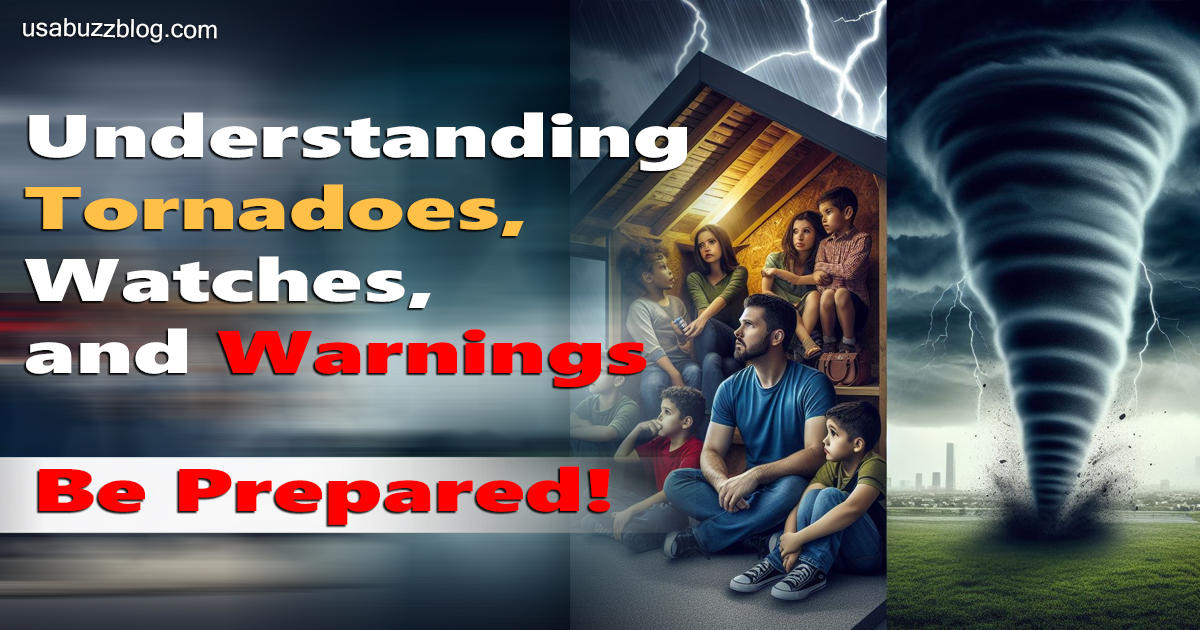
Introduction: The Power and Peril of Tornadoes
Tornadoes, swirling columns of air connecting a thunderstorm to the ground, are some of nature’s most destructive forces. These violent storms can leave a trail of devastation, tearing apart buildings, uprooting trees, and hurling debris through the air at incredible speeds. While tornadoes can strike anywhere in the world, they are most common in the United States, particularly in the central plains region known as “Tornado Alley.”
Understanding the difference between a tornado watch and a tornado warning is crucial for staying safe in severe weather situations. This article will delve into the world of tornadoes, explaining these critical terms, offering essential safety tips, and empowering you to protect yourself and your loved ones during these powerful storms.
When the Skies Turn Threatening: Tornado Watches and Warnings
The National Weather Service (NWS) plays a vital role in keeping the nation informed about potential tornado threats. They issue two key advisories to alert communities about severe weather:
- Tornado Watch: A tornado watch indicates that conditions are favorable for tornadoes to develop within a specific geographic area and timeframe (typically several hours). This is a time to be vigilant, stay informed about weather updates, and have a plan in place in case a tornado warning is issued.
- Tornado Warning: A tornado warning is a more serious advisory, indicating that a tornado has been spotted visually or detected by radar within the designated area. This is a time to take immediate shelter and follow safety protocols to protect yourself from the storm’s fury.
Knowing the difference between these advisories can make all the difference in an emergency situation. A tornado watch serves as a heads-up, while a tornado warning demands immediate action.
Understanding the Storm: Recognizing Signs of a Tornado
While relying on official weather advisories is crucial, remaining aware of potential signs of a developing tornado can provide valuable seconds of warning. Here are some key visual cues to watch out for:
- A dark, low-lying cloud rotating rapidly: This is often referred to as a wall cloud or a lowering.
- A funnel cloud extending from the base of a thunderstorm: This is a more definitive sign that a tornado is forming.
- Large hail: The presence of large hail can often accompany storms with a heightened risk of tornadoes.
- A loud, roaring sound: Tornadoes can produce a distinct low-pitched roar or rumbling sound.
If you witness any of these signs, don’t hesitate! Seek shelter immediately and tune in to local weather reports or emergency broadcasts for the latest updates.
Taking Action: Essential Tornado Safety Tips
Being prepared for a tornado can significantly increase your chances of staying safe during these hazardous events. Here are some essential safety tips to follow:
Before a Tornado:
- Develop a tornado safety plan: Discuss a designated safe haven in your home (basement or interior room on the lowest floor) with your family.
- Prepare a tornado emergency kit: Include essential supplies like non-perishable food, water, first-aid kit, flashlight, batteries, and a battery-powered radio.
- Stay informed: Sign up for local weather alerts and monitor weather forecasts regularly during severe weather seasons.
During a Tornado Watch:
- Stay alert and listen for updates: Pay close attention to weather reports and advisories from the National Weather Service.
- Prepare your designated shelter: Clear the area of furniture and objects that could become airborne.
During a Tornado Warning:
- Seek shelter immediately: Move to your designated safe area and get down low, covering your head and neck with your arms.
- Stay away from windows: Windows are particularly vulnerable to flying debris during a tornado.
- Don’t open windows: Opening windows during a tornado will not equalize pressure and can actually make the situation worse.
- If caught outdoors: Find a low-lying ditch or depression and lie flat, covering your head and neck with your arms.
Beyond the Storm: Recovery and Resources for Tornado-Ravaged Communities
Tornadoes can leave a trail of devastation, shattering homes, businesses, and infrastructure. Rebuilding in the aftermath requires a collective effort from individuals, communities, and government agencies. Here are some resources that can guide tornado-ravaged communities through the recovery process:
- The National Weather Service (NWS): As mentioned earlier, the NWS website (https://www.noaa.gov/weather) provides valuable information and resources for tornado preparedness and recovery. They offer post-storm safety tips, damage assessment reports, and links to helpful recovery resources.
- The Federal Emergency Management Agency (FEMA): FEMA is a crucial resource for individuals and communities impacted by disasters like tornadoes. They offer financial assistance for individuals and families for temporary housing, repairs, and other essential needs. You can register for FEMA assistance online at https://www.disasterassistance.gov/ or by calling 1-800-621-FEMA (3362).
- The Small Business Administration (SBA): The SBA provides low-interest disaster loans to help businesses of all sizes recover from tornado damage. These loans can be used for repairs, property replacement, and working capital. Information on SBA disaster loans can be found at https://www.sba.gov/funding-programs/disaster-assistance or by calling 1-800-659-2955.
- Volunteer Organizations: Numerous volunteer organizations dedicate themselves to disaster relief efforts. These groups provide essential services like debris removal, temporary housing assistance, and emotional support. You can find volunteer opportunities by contacting your local chapter of organizations like the American Red Cross (https://www.redcross.org/) or Salvation Army (https://www.salvationarmyusa.org/usn/).
- Community Resources: Local and state government agencies often offer additional resources for tornado recovery. These resources can include mental health counseling, legal assistance, and rebuilding programs. Contact your local emergency management office or city/county government for information on available resources.
Frequently Asked Questions (FAQs)
1. What is the difference between a tornado watch and a warning?
- Tornado Watch: A watch indicates that conditions are favorable for tornadoes to develop in a specific area within a timeframe (usually several hours). It’s a time to be vigilant, stay informed, and have a plan in place.
- Tornado Warning: A warning signifies that a tornado has been spotted visually or detected by radar within the designated area. This is a time to take immediate shelter and prioritize your safety.
2. How can I prepare a tornado safety plan for my family?
- Identify a safe haven: Choose an interior room on the lowest floor of your home, preferably a basement. This location offers the most protection from flying debris.
- Practice shelter drills: Conduct regular tornado drills with your family to ensure everyone knows where to go and what to do in case of a warning.
- Assign roles: Designate someone to stay informed about weather updates and another to gather emergency supplies during a watch.
3. What should I include in my tornado emergency kit?
- Non-perishable food and bottled water: Aim for a three-day supply for each family member.
- First-aid kit: Include essential medical supplies like bandages, antiseptic wipes, and pain relievers.
- Flashlight and batteries: Ensure you have enough batteries to keep your flashlight functional.
- Battery-powered radio: This allows you to stay informed about weather updates even if the power goes out.
- Cell phone charger: Having a portable charger ensures your phone remains operational for communication.
- Cash: In case of power outages or disrupted services, cash can be helpful for essential purchases.
4. What are some signs of a developing tornado that I should be aware of?
- A dark, low-lying cloud rotating rapidly (wall cloud or lowering).
- A funnel cloud extending from the base of a thunderstorm.
- Large hail accompanying the storm.
- A loud, roaring or rumbling sound.
5. What should I do if I’m caught outdoors during a tornado?
If you’re caught outdoors during a tornado and there’s no time to reach a proper shelter:
- Find a low-lying ditch or depression and lie flat on your stomach.
- Cover your head and neck with your arms, tucking your elbows in for added protection.
- Stay away from trees, power lines, and other objects that could be uprooted or blown over by the storm.
Conclusion: Knowledge is Power – Be Prepared for Tornadoes
Tornadoes are powerful and unpredictable forces of nature. However, by understanding the terminology, recognizing the signs, and taking proactive measures, you can significantly increase your chances of staying safe during these severe weather events. Develop a tornado safety plan with your family, prepare an emergency kit, and stay informed about weather forecasts and advisories. Remember, knowledge is power. By being prepared, you can weather the storm – literally and figuratively.
More Interesting Perks:
- Chelsea Fans: Beyond the Bridge! Global Craze Revealed
- IPL All-Stars: Sanju Samson & The Rivalry Between Punjab Kings & CSK vs Mumbai Indians
- Bumrah vs. CSK: Can the Yorker King Conquer the Yellow Brigade?
- Gunners Face Villans: A Tactical Preview of Arsenal vs Aston Villa in the Premier League
- An Ultimate Guide to Upcoming Solar Eclipses: Don’t Miss the Next One! Beyond 2024
- Exploring Wonders: Best 5 Must-Visit Tourist Attractions in the USA
- Romantic Retreats: 5 Best Vacation Spots for Couples in the USA
- Discover the Best Vacation Spots in the USA: Your Ultimate Travel Guide 2024
- Unlocking The Best National Parks: Exploring the 3 Wonders
- 5 Best Waterfalls of 2024: New Hampshire’s Cascading Wonders
- Exploring the 5 Best Places in the US: Must-Visit in 2024
Subscribe To Get New Post Updates VIA Email

Anwar Hussain
As an Architectural and Interior 3D Visualization Expert, I spend my days crafting stunning visuals that showcase the potential of design. But my passion for storytelling extends beyond the screen. At usabuzzblog.com, I leverage my design expertise to provide insightful and engaging content on Technology, Health & Fitness, Travel, News, Architecture, interior design, and the broader creative landscape. Join me as I explore the latest trends, share design tips, and unveil the stories behind the spaces we inhabit.













